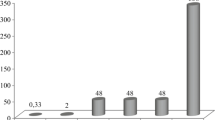Abstract
Results of a physicochemical study of hydrolysis and gel formation in ethylsilicate binders without organic solvents are presented. The effects of the kind and amount of acid catalyst and the proportion of water to ethylsilicate on the thermal effect of the hydrolysis reaction, the sol-gel transformation, and the properties of the binder are investigated. IR spectra of gels of hydrolysates prepared by rapid and slow hydrolysis are presented. The technological aspects of production of binders are considered.
Similar content being viewed by others
References
Ren Xu, E. J. A. Pope, and J. D. Mackenzie, “Structural evolution of sol-gel systems through viscosity measurement,”J. Non-Cryst. Solids,106(1–3), 242–245 (1988).
O. F. Kinouchi and M. A. Aegerter, “Rheology of the gelation process of silica gel,”J. Non-Cryst. Solids,105(3), 191–197 (1988).
G. Oreal, L. L. Hench, J. Artaki, J. Jonas, and T. W. Zerda, “Effect of formamide additive on the chemistry of silica sol-gels,””J. Non-Cryst. Solids,105(3), 223–231 (1988).
V. B. Lazarev, S. G. Ambartsumyan, V. I. Privalov, G. P. Panasyuk, A. I. Mishutin, and A. G. Panasyuk, “A study of the hydrolysis of tetraethoxysilane in a mixture with ethane and concentrated hydrochloric acid by the method of high-resolution +lH NMR,”Vysokochist. Veshchestva, No. 1,43–50 (1989).
A. H. Boonstra and T. N. M. Bernard,“The dependence of the gelation time on the hydrolysis time in a two-step SiO2 sol-gel process,”J. Non-Cryst. Solids,105(3), 207–213 (1988).
Ya. I. Shklennik and V. A. Ozerov (eds.),Casting by Melting-Out Models [in Russian], Mashinostroenie, Moscow (1971).
V. T. Zagoskin, G. D. Semchenko, V. I. Skakun, et al.,“A method for fabricating ethylsilicate binder, Inv. Certif. USSR No. 847295,”Oktr. Izobr. Prom. Obraztsy. Tov. Znaki, No. 17,89 (1981).
G. D. Semchenko,“Low-temperature synthesis of SiC in heat treatment of gels of hydrolyzed ethylsilicate,”Ogneup. Tekh. Keram.,No. 9,14-19(1996).
Author information
Authors and Affiliations
Additional information
The preceding papers of the series have been published in Nos. 1–3,1999.
Rights and permissions
About this article
Cite this article
Semchenko, G.D. A new direction in the creation of ceramic materials with a specified phase composition and structure. Part I. Preparation of binders for ceramic production by the sol-gel method. 3. Hydrolysis and gel formation in ethylsilicate binders without organic solvents. Refract Ind Ceram 40, 179–184 (1999). https://doi.org/10.1007/BF02762279
Issue Date:
DOI: https://doi.org/10.1007/BF02762279




